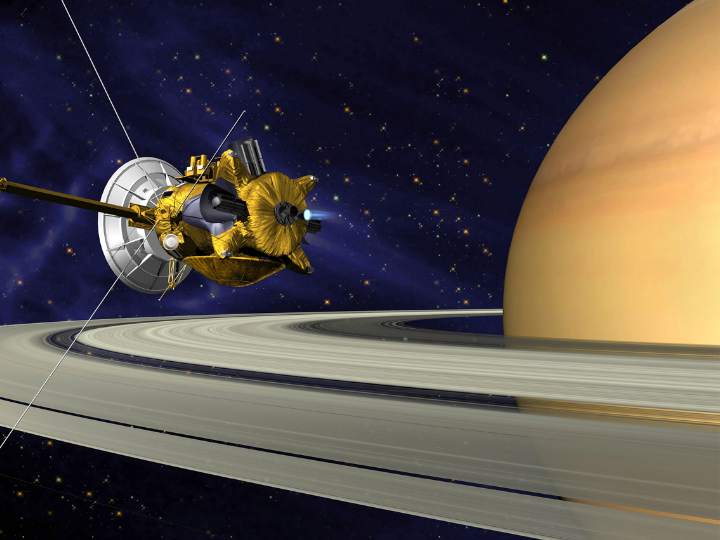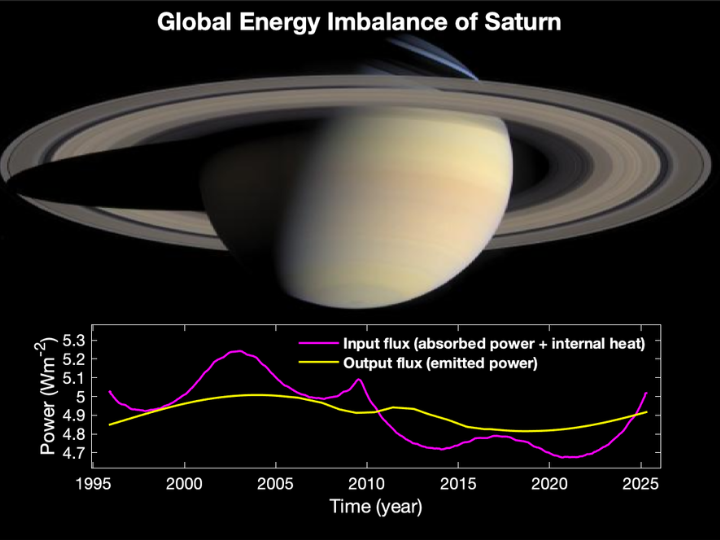Saturn’s energy budget has been found to be severely unbalanced. The extent of the difference between energy in and energy out has surprised planetary scientists, even though the cause has been known since Kepler. An analysis of the imbalance has suggested it contributes to the planet’s giant storms, and raised questions about whether something similar occurs on other gas giants.
Every planet has an energy budget, the balance of the radiation it absorbs from the Sun, and what it emits back into space. These are not exactly equal, since the planets also have internal sources of energy from the decay of radioactive elements. However, in most cases, the internal source is quite minor.
However, a long-term balance can be made up of temporary imbalances, where a planet heats up or cools down for a while. Earth is doing that now through human intervention, but Saturn has also been found to have unexpectedly large imbalances in the course of its orbit.
“This is the first time that a global energy imbalance on a seasonal scale has been observed on a gas giant,” said Prof. Liming Li from the University of Houston in a statement. “Not only does this give us new insight into the formation and evolution of planets, but it also changes the way we should think about planetary and atmospheric science.”

Artist’s impression of Cassini close to Saturn’s rings
Image Credit: University of Houston
Like every planet, Saturn’s orbit is not perfectly circular, and indeed it is more elongated than that of most of its peers, although far more rounded than most comets. Inevitably it absorbs more heat when it’s closer to the Sun than when it is further away – unlike Earth, it doesn’t have a mix of oceans and continents with their very different heat absorption to complicate things.
Eventually, the extra heat absorbed during the closer part of its orbit must be radiated away, but an analysis of radiation collected by Cassini and Earth-based telescopes has found that can take quite a long time. Although storms are not as visible on Saturn as Jupiter, since the color contrast they create is much smaller, they can be large and long-lasting. The authors of this study think this is related to the energy imbalance. For example, a storm in Saturn’s northern mid-latitudes in 2010-2011 emitted more heat than the areas around it, possibly because a build-up in heat needed to be released somehow.

Perhaps surprisingly Saturn’s energy output varies more smoothly than the input. Since Cassini dived into Saturn, Earth-based telescopes’ measurements were used
Image Credit: NASA/JPL
This discovery raises two big questions: why has it taken so long to realize this, and is the same true of the other gas giants?
A few factors answer the first. “Saturn, like the other gas giants, has another energy input in the form of deep internal heat affecting its thermal structure and climate,” University of Houston graduate student Xinyue Wang explained. Knowing this is easy, but measuring it can be more difficult.
“For Saturn, examination of the radiant energy at the top of the atmosphere is more complicated because of its rings,” Wang and co-authors write. The rings cast great shadows on Saturn during certain parts of its orbit, which of course leads to less incoming energy. On the other hand, they can get in the way of our efforts to measure the energy the planet is emitting from the top of its atmosphere.
“In current models and theories of the atmosphere, climate, and evolution of the gas giants, the global energy budget is assumed to be balanced,” Wang said. “But we believe our discovery of this seasonal energy imbalance necessitates a reevaluation of those models and theories.”
No similar energy imbalance has been detected for the other gas giants, which is strange. After all, the much smaller ring systems don’t interfere with our observations so much, so if it’s there we’d expect to have seen it.
Saturn has the most elongated orbit of the gas giants, but Uranus and Jupiter are not far behind. These things are measured by the orbit’s eccentricity, which is 0.052 for Saturn and 0.047 and 0.049 for the other two. Uranus has the complicating factor of practically rotating on its side, which the authors think should increase imbalances. Neptune, on the other hand, has an exceptionally round orbit and a normal axis of rotation.
The study is open access in Nature Communications.
Source Link: Saturn Has A Massive Energy Imbalance And It’s Creating Giant Storms